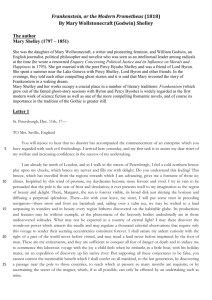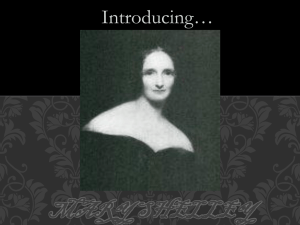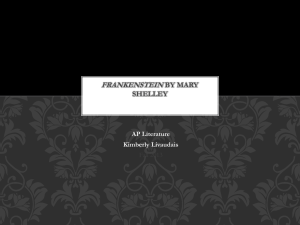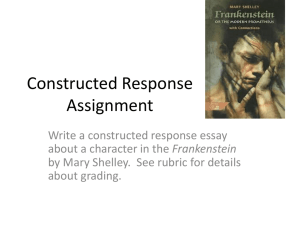Mary Wollstonecraft (Godwin) Shelly was the daughter Mary
advertisement
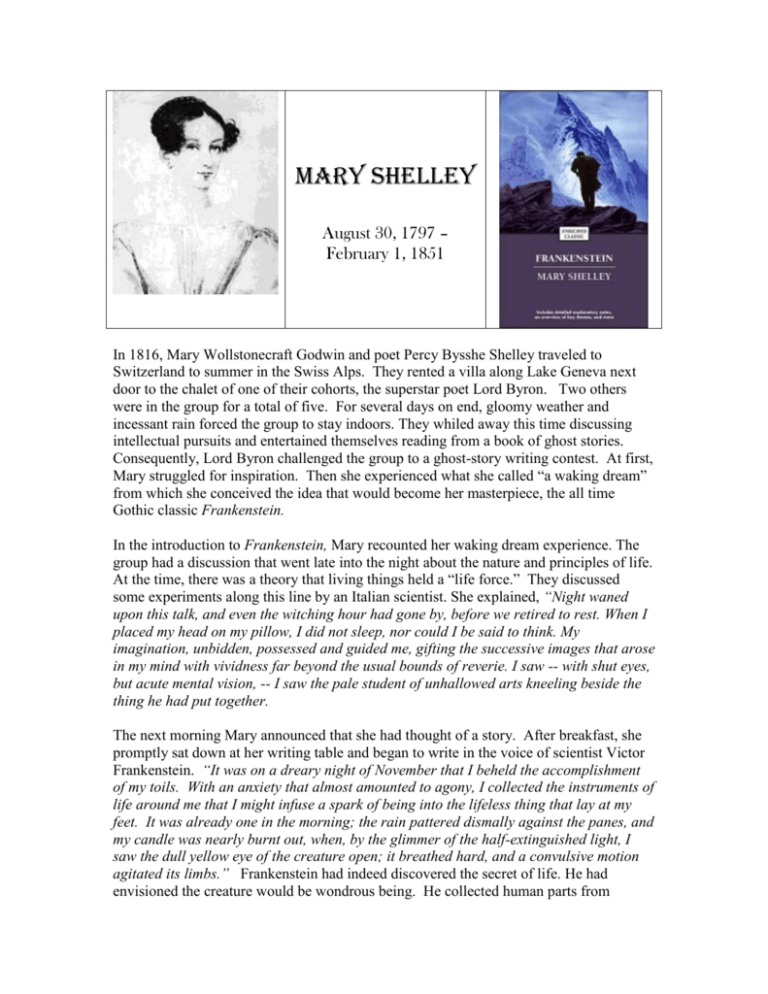
Mary ShellEy August 30, 1797 – February 1, 1851 In 1816, Mary Wollstonecraft Godwin and poet Percy Bysshe Shelley traveled to Switzerland to summer in the Swiss Alps. They rented a villa along Lake Geneva next door to the chalet of one of their cohorts, the superstar poet Lord Byron. Two others were in the group for a total of five. For several days on end, gloomy weather and incessant rain forced the group to stay indoors. They whiled away this time discussing intellectual pursuits and entertained themselves reading from a book of ghost stories. Consequently, Lord Byron challenged the group to a ghost-story writing contest. At first, Mary struggled for inspiration. Then she experienced what she called “a waking dream” from which she conceived the idea that would become her masterpiece, the all time Gothic classic Frankenstein. In the introduction to Frankenstein, Mary recounted her waking dream experience. The group had a discussion that went late into the night about the nature and principles of life. At the time, there was a theory that living things held a “life force.” They discussed some experiments along this line by an Italian scientist. She explained, “Night waned upon this talk, and even the witching hour had gone by, before we retired to rest. When I placed my head on my pillow, I did not sleep, nor could I be said to think. My imagination, unbidden, possessed and guided me, gifting the successive images that arose in my mind with vividness far beyond the usual bounds of reverie. I saw -- with shut eyes, but acute mental vision, -- I saw the pale student of unhallowed arts kneeling beside the thing he had put together. The next morning Mary announced that she had thought of a story. After breakfast, she promptly sat down at her writing table and began to write in the voice of scientist Victor Frankenstein. “It was on a dreary night of November that I beheld the accomplishment of my toils. With an anxiety that almost amounted to agony, I collected the instruments of life around me that I might infuse a spark of being into the lifeless thing that lay at my feet. It was already one in the morning; the rain pattered dismally against the panes, and my candle was nearly burnt out, when, by the glimmer of the half-extinguished light, I saw the dull yellow eye of the creature open; it breathed hard, and a convulsive motion agitated its limbs.” Frankenstein had indeed discovered the secret of life. He had envisioned the creature would be wondrous being. He collected human parts from dissecting rooms and morgues, and he used great care in his selection. But when he finished, he realized it was all wrong and was not a thing of beauty. Horrified by what he created, Frankenstein was repulsed, and he abandons the creature to his own devices. And so begins this classic tale of horror written by an 18 year old girl. Mary Wollstonecraft (Godwin) Shelley was the daughter of two famous parents. Her father was the philosopher and writer, Edwin Godwin. Her mother was Mary Wollstonecraft, an early female philosopher, author, feminist and pioneer for female education. Wollstonecraft died from complications of childbirth when the child Mary was only 10 days old. Godwin remarried, and this second wife brought two stepsisters into the home. Mary found herself in a “Cinderella” situation with a jealous stepmother that forced Mary into the household chores, controlled and restricted access to her father and tried to thwart Mary’s opportunities for an education. Despite her stepmother’s efforts, Mary earned a superb education at home via her father’s intellectual circle, the use of his extensive library and listening to his conversations with the leading writers and thinkers of day. Percy Bysshe Shelley was among the intellectuals that frequented the Godwin home. Celebrated as political radical and aspiring poet, Shelley romantically captivated Mary; in return, he fell in love with her mind. In 1814, despite scores of opposition, the ties of the heart prevailed, and Mary and Percy eloped to France. Mary was one month shy of 17. Their union was not without its joys and sorrows. Never content in one place, Percy moved the family about as he began work on his poetry in earnest. In 1818, they left England and moved to Italy where they would spend the next four years. The couple’s first three children died; their first child, a daughter lived only11 days, next another daughter died who lived one year, and the following year their beloved son William died at age three. Mary also suffered a miscarriage that nearly killed her. Only one child, a son Percy Florence, lived to adulthood. During the time in Italy, they had a circle of important friends that still included Lord Byron. They both enjoyed successes on their literary pursuits. Percy published several political tracts and established a name among the important English poets of the day. Mary published a journal of their exploits as a travel book in 1817; Frankenstein came out the following year, then her novel Mathilda. Then in the summer of 1822, tragedy struck. Percy drowned in a sailing accident. Mary was devastated. She was 24 and a widow. She returned to England to raise their remaining son alone, and she turned to Percy’s unfinished works. She edited and published his Posthumous Poems and his Poetical Works and Letters. She also wrote several more novels of her own: Valperga: the Life and Adventures of Castruccio, Prince of Lucca, The Fortunes of Perkin Warbeck, Lodore and Falkner and several short stories. None of these matched the success of Frankenstein though. Almost two centuries later, her story of the monster is still in print and has inspired more than 50 films. Mary Shelley never remarried. She died at home in London in 1851 at the age of 53.

